Unforgettable Dinner with a Maiko in Kyoto: Review of What to Expect
Have you ever thought about what it would be like to enjoy dinner with a maiko in Kyoto? I know the feeling! Since the stars finally aligned for me to experience it, I can easily say it was one of the highlights of all my trips to Japan over the past decade!
For many years, I’d hoped for the chance to meet maiko or geisha over dinner (more on their differences in a moment), but the experience was tightly limited to locals in the know.
Reluctantly, like most of us I had to settle for briefly catching glimpses of them from afar in between appointments on Gion’s streets… Until now.

Combined with an evening walking tour beneath lantern lights, during my evening with a maiko I learnt quite a few new things I hadn’t on my previous visits to Kyoto. The maiko’s work is truly one of the most special Japanese traditions to help keep alive.
If you’d like to know how to see geisha in Kyoto, ways to spot real from fake, have the chance to ask questions, enjoy seasonal dishes, what to expect, and how to book a Kyoto geisha dinner in English, read on for more!
I took part in this experience as a press invite. All thoughts and opinions are my own. This post contains affiliate links at no extra cost to you. I may earn a small commission if you click through and make a purchase.
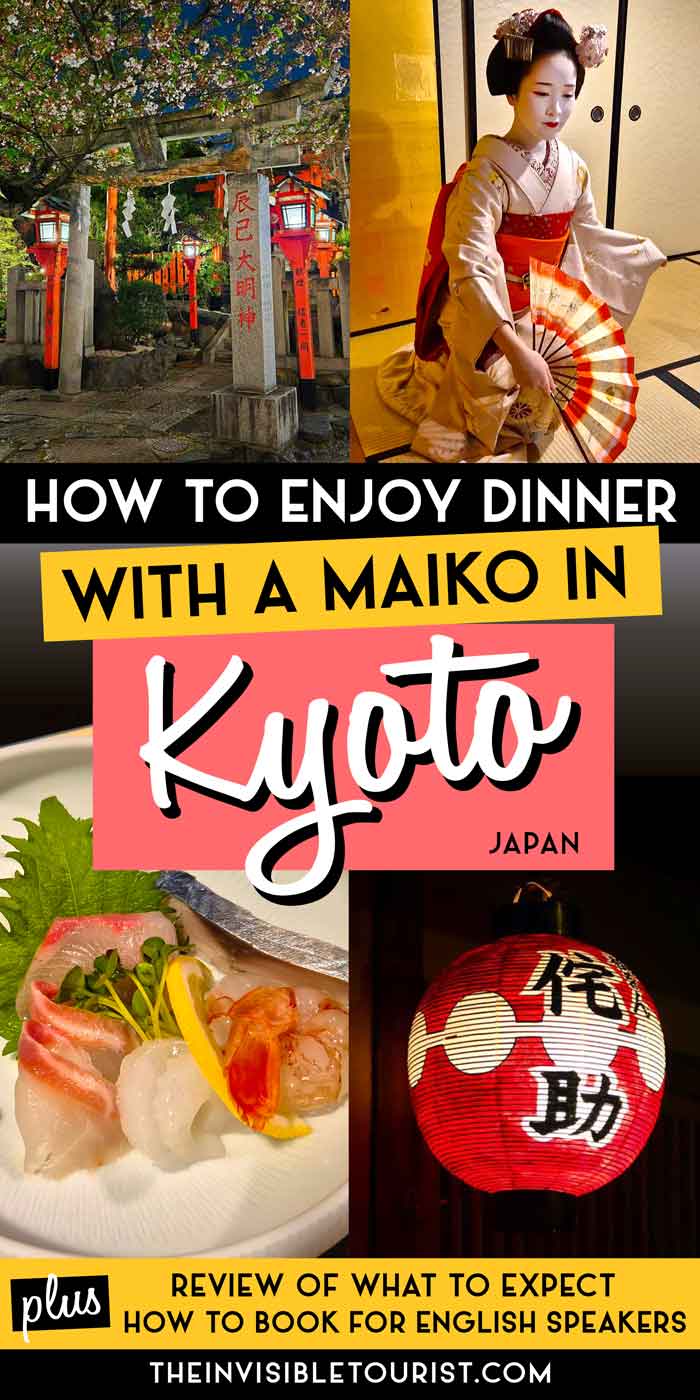
Maiko vs geiko vs geisha: Definitions of each
What are geisha and maiko? You may have heard the words geisha, geiko and maiko used to describe Japanese hostesses. If you already know the differences, skip down the page to my tour review.
If you’re not familiar, these women are highly skilled entertainers in arts such as calligraphy, tea ceremonies, singing, dancing, flower arranging and much more – not what Western lore would have us believe. Here are the differences:
- Geisha is a more general term and means “art person” or “performing artist.” This term is recognised by most foreign tourists.
- Geiko is the Kyoto dialect for geisha and means “master artist,” therefore, masters of their art.
- Maiko is a geiko in training, like an apprentice. It can take 5 years to fully become a geiko, and most girls start when they are 15 years old.
The walking tour and dinner on this experience is in the preserved Gion neighbourhood. It’s my favourite area for accommodation and I recommend it if you’re hoping to avoid crowds – I promise there is a method to my madness!
TIP: Read my tried-and-tested guide to ryokan and hotels in Gion, Kyoto for my advice on places I’ve stayed during my five visits to this historic neighbourhood.
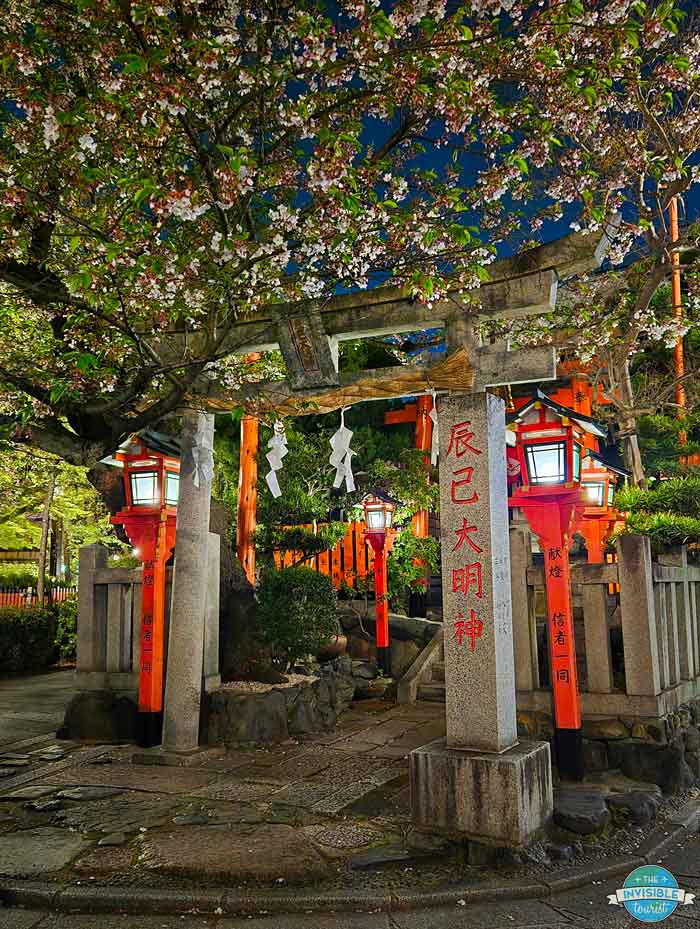
Dinner with a maiko in Kyoto review: What to expect
Wondering where to see geisha in Kyoto? Like I did for many years, you could take your chances in the evenings trying to see them walking briskly through the Gion and Pontocho areas.
However, unlike some rude tourists who chase maiko down the streets for photos, we can instead have a beautiful dining experience and interact with them! What better way to support their art, and have a wonderful memory to treasure afterwards?
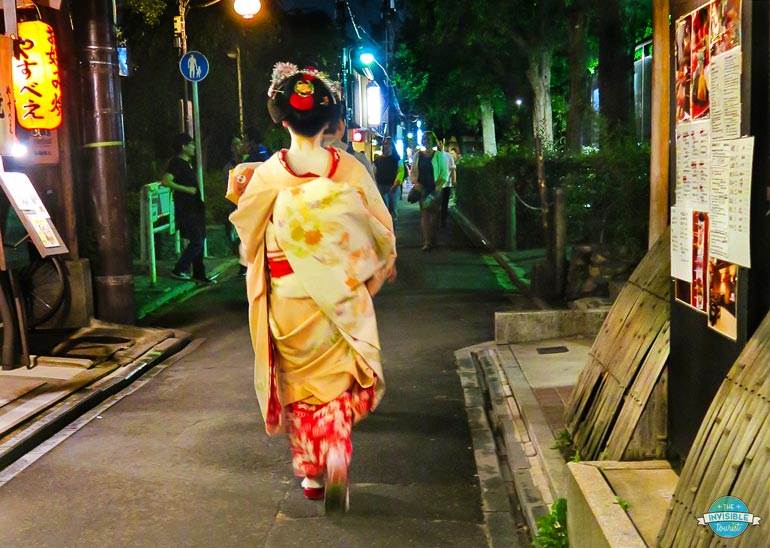
Over the years, I’ve also taken other tours with MagicalTrip, such as this Fushimi Inari Hidden Hiking Tour, Kyoto bar hopping tour, Kyoto tea ceremony, a Kamakura day trip from Tokyo, Tokyo bar hopping tour, and they are always so fun! You can discover all their Kyoto tours here →
With all that said, here’s how the evening unfolded!
Finding the meeting place
The meeting place for my dinner with a maiko in Kyoto was at Izumo no Okuni Statue, right by Gion Shijo Station. This area is much busier than it was years ago, so keep an eye out for your guide with a MagicalTrip sign a few metres down the footpath from the statue.
Our lovely guide and interpreter for the evening was Hikari-san, a local Kyoto resident. She ensured our tour was so much fun, full of laughs and did a brilliant job interpreting with our maiko. It was just like chatting with an old friend!
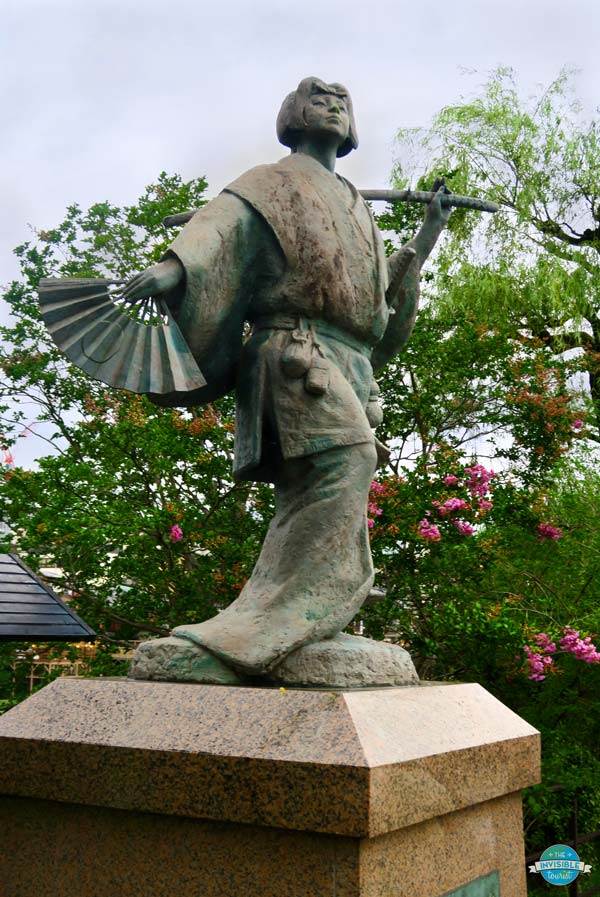
Learning the meanings of things hiding in plain sight
To begin the tour, Hikari-san walked us by some of Kyoto’s most iconic photo spots, pointing out details of the local shops that most tourists would overlook (myself included until now).
Finally I know the meanings behind Gion’s red lanterns with white dots on them, why there is wooden latticework on the machiya (old dark-brown buildings) and the real purpose of the arched bamboo fences along shopfronts. I always thought it was to hide modern air conditioning units but I was wrong, hehe.
Hikari-san also explained how the profession of geiko came into being over the centuries. It’s quite a fascinating story, and remarkable this practice is still alive today!
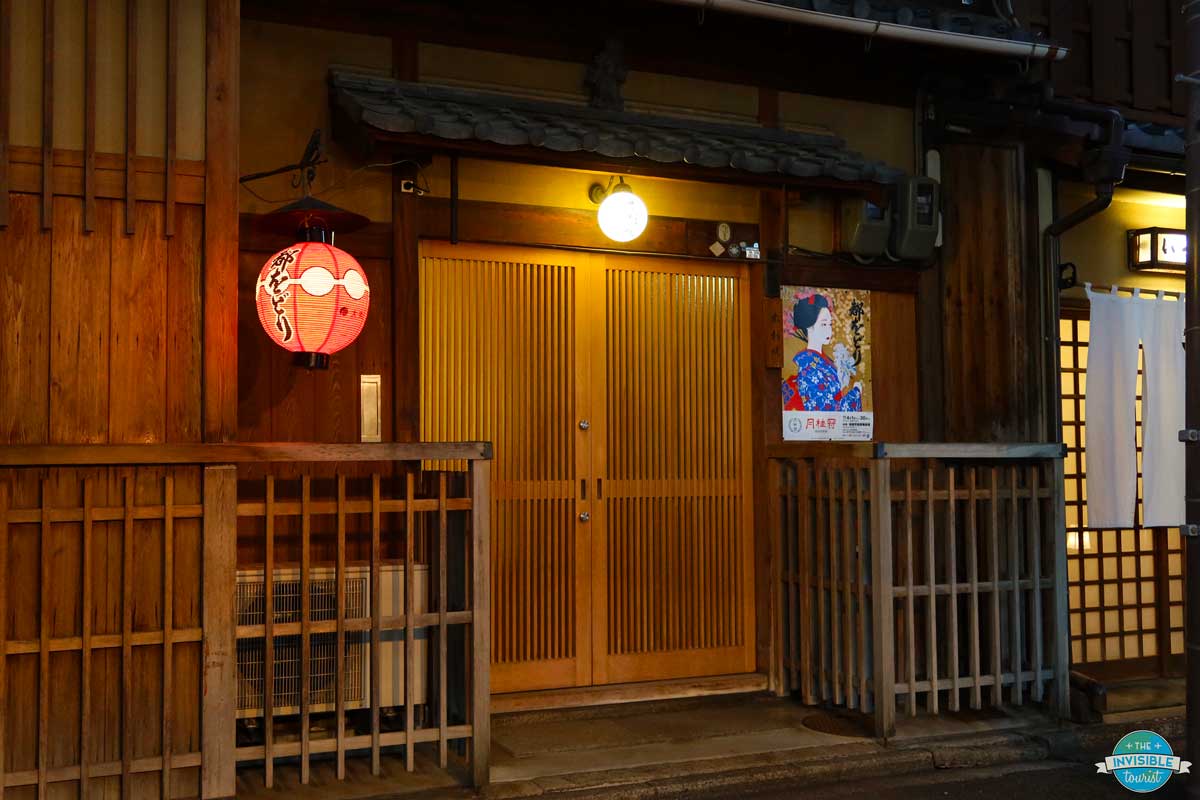
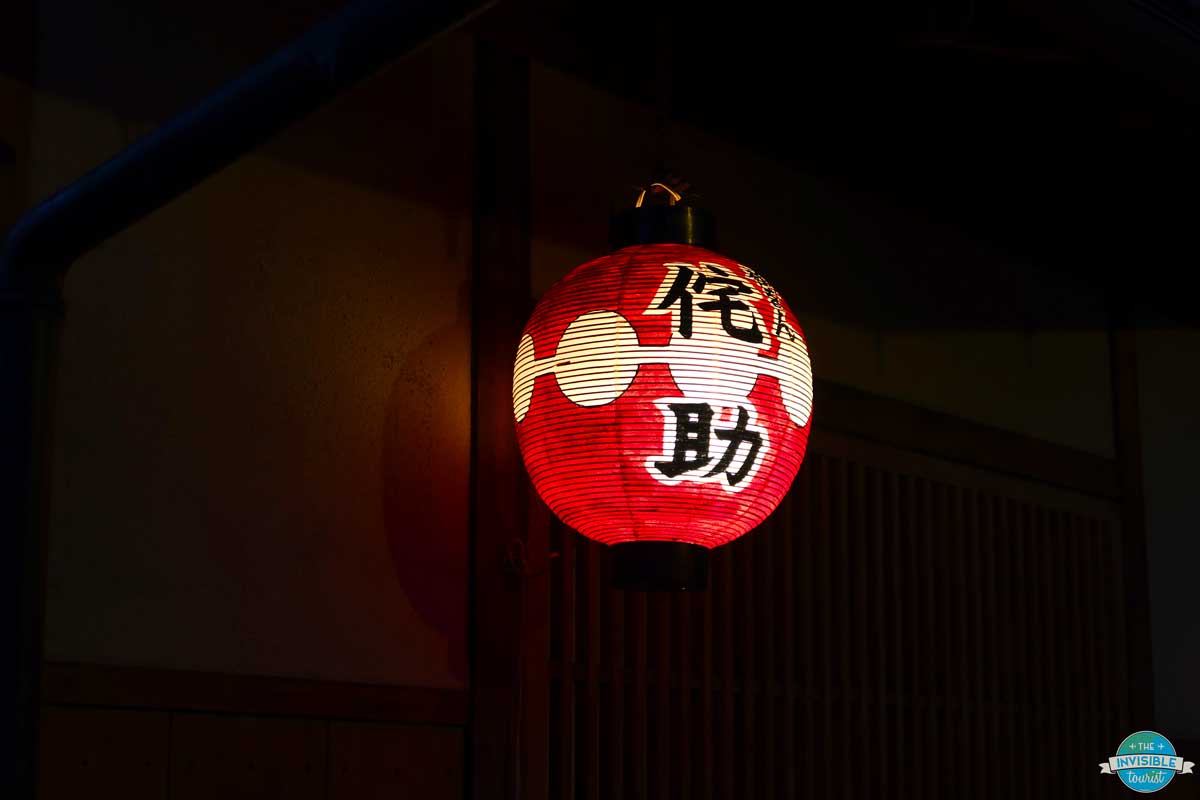
Arriving at the traditional Kyoto restaurant
After a few photos of our group out front, Hikari-san welcomed us to our traditional restaurant where we would spend the next few hours.
TIP: Be sure to either wear or bring along good socks – it’s shoes off, of course!
This restaurant has been operating for over a century. Walking up its narrow staircase, it felt quite special and exclusive being able to dine at a place like this! Our small group was warmly welcomed into a private room with tatami flooring.
Sampling seasonal dishes
Before being introduced to our maiko, we were able to leisurely enjoy a 7 course meal prepared with fresh seasonal ingredients.
Unsurprisingly, the presentation was immaculate. Each dish was a miniature artwork bursting with flavour. It was easy to tell just how much care and attention to detail had gone into creating each course. Dishes included tempura, bamboo shoots, sashimi, grilled beef and fish, dipping sauces to name a few.
To accompany this authentic Kyoto meal, we could take our pick of unlimited Japanese drinks, including nihonshu (sake), umeshu (plum wine), biru (Japanese beer), and more as well as non-alcoholic beverages.
Over our meal, Hikari-san explained how to tell a maiko from a geisha through visual differences, ways to spot fakes through hair accessories, attire and make-up, and how we should interact with our maiko to best “blend in.”
TIP: Learn some extra local etiquette with my guide to cultural do’s and don’ts in Japan.
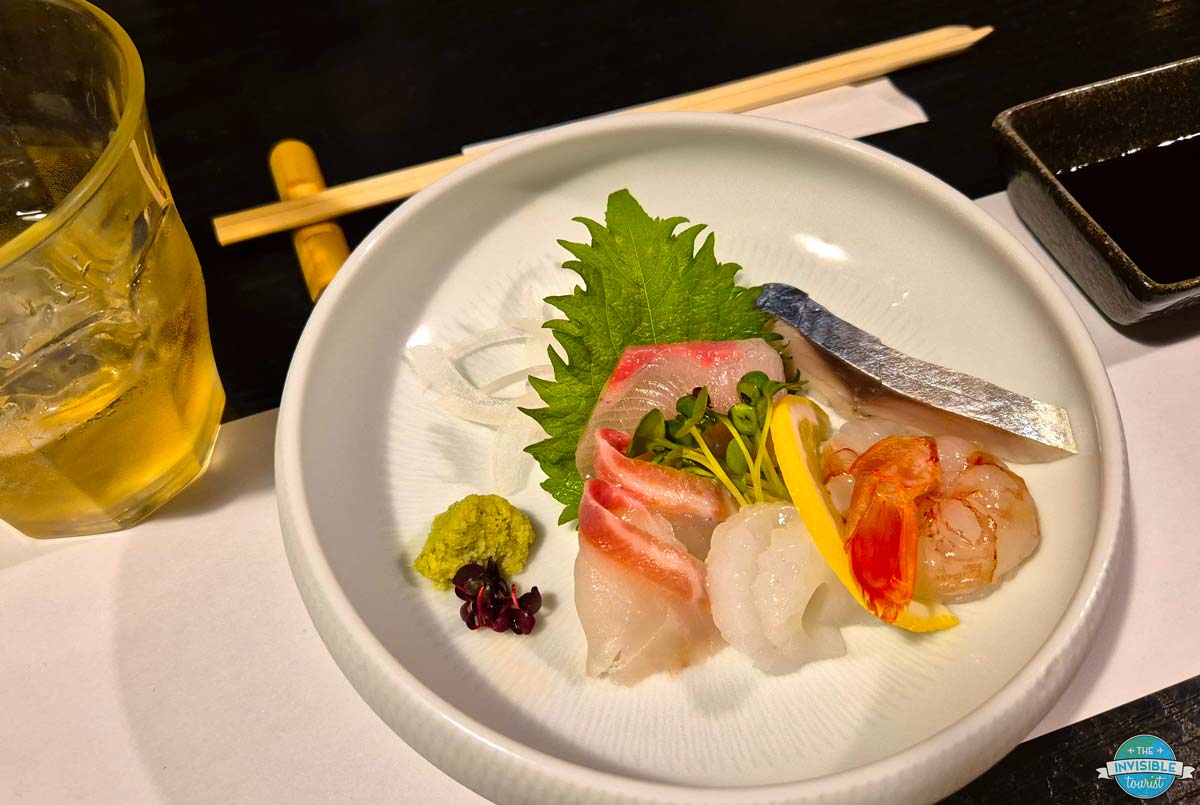
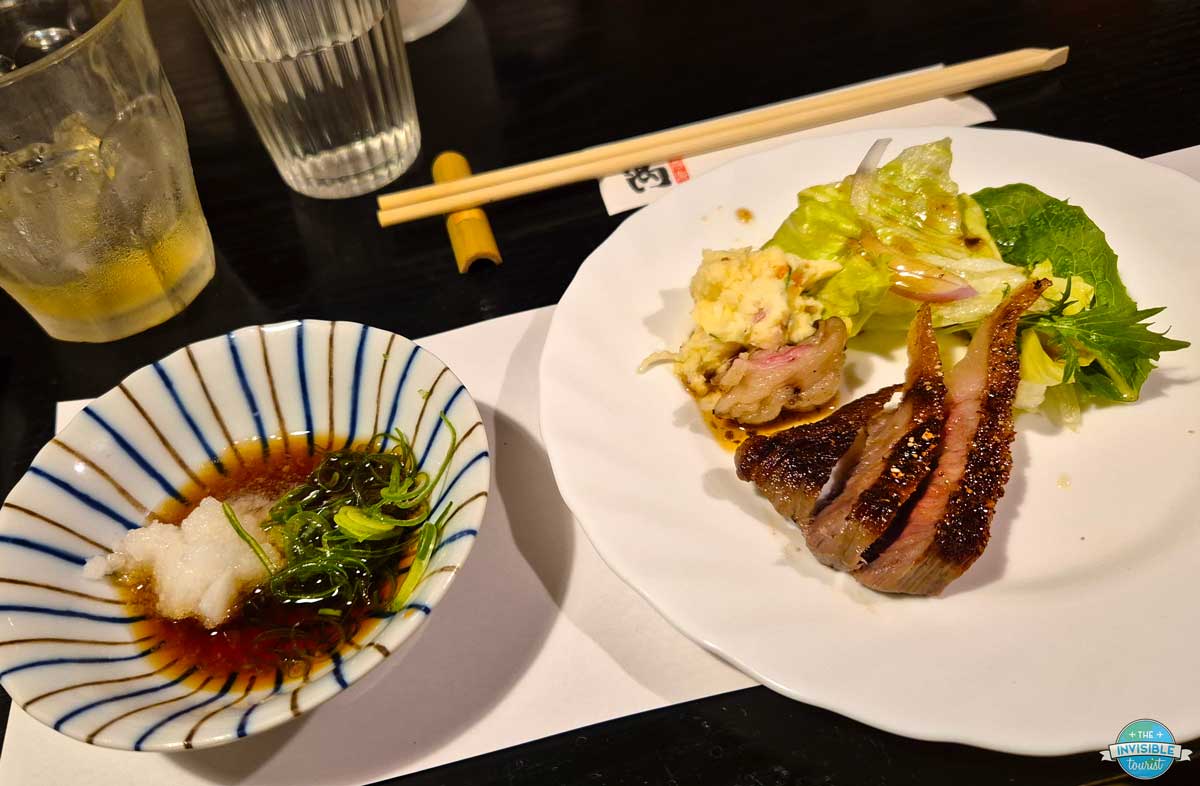
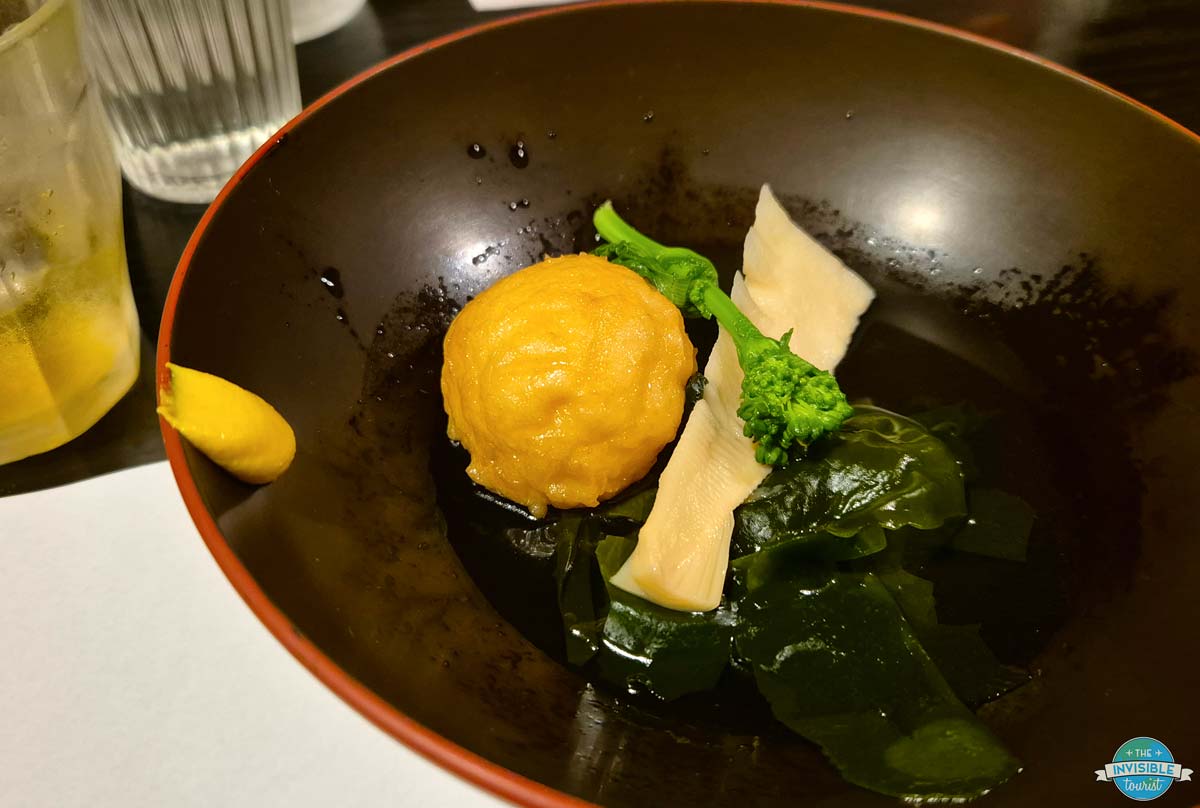
Meeting our maiko
Our attention fixated on the sliding door opening, I heard a few soft gasps as our maiko made her entrance into our room. She was the embodiment of elegance and grace – one of the most beautiful things I had ever seen!
Passing around a small business card, we learnt our maiko’s performing name was Kikushizu-san. Standing by Hikari-san’s side, Kikushizu-san allowed us time to admire her stunning kimono, make-up and accessories.
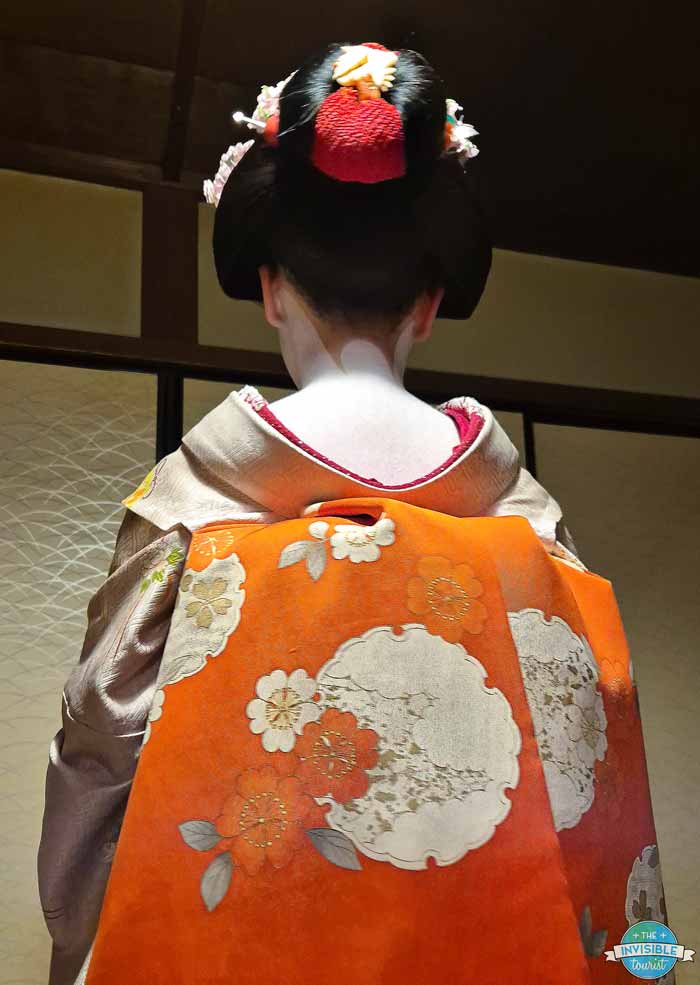
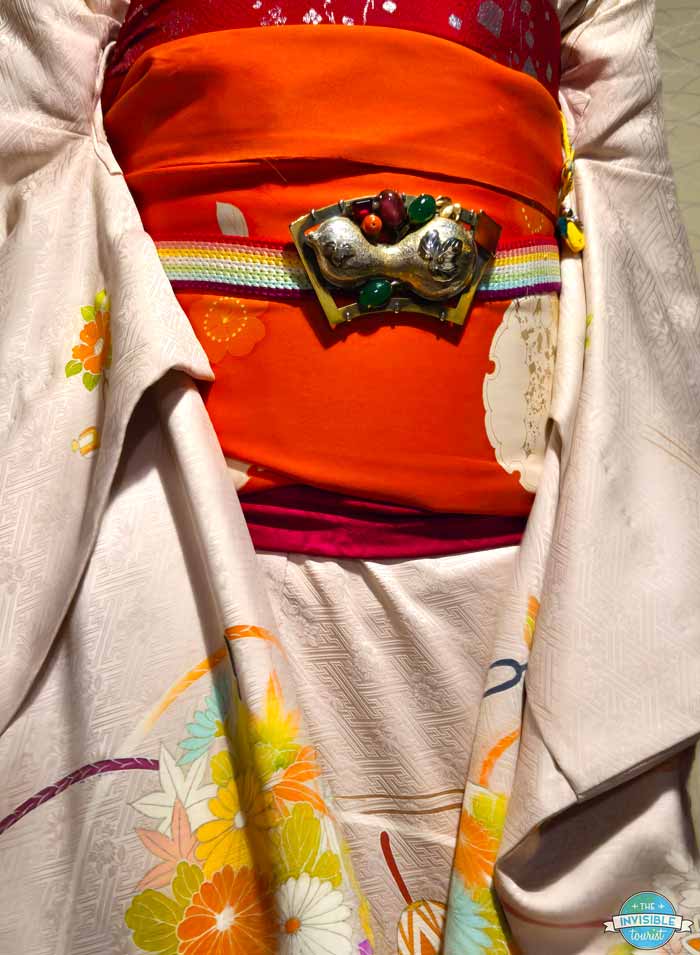
Hikari-san tested our knowledge from earlier and we correctly guessed Kikushizu-san was in her 3rd year of training to become a geiko. Through asking Kikushizu-san questions and Hikiari-san’s translations, we learnt about:
- A maiko’s day-to-day life
- Costs associated with her attire (and who pays for it)
- How often her hair is styled (including the pros and cons about it)
- Why she decided to become a maiko
- Her favourite things about being a maiko (and the downsides)
- How she enjoys spending time on her days off.
There are plenty of misconceptions about maiko and geiko out there, so it was lovely to have our questions answered directly by one. During this time Kikushizu-san also was a very attentive hostess, ensuring our drinks were topped up at all times.
As we enjoyed more courses of our meal, Kikushizu-san performed a beautiful dance for us to the sounds of shamisen (a traditional Japanese string instrument).

Playing maiko drinking games
After a beautiful dance performance, Kikushizu-san taught us some entertaining games which we were all able to participate in. She sang folk songs to accompany them.
Tora Tora Tora
The first one was called Tora Tora Tora (Tiger Tiger Tiger). It’s similar to “Scissors, Paper, Rock” but instead of only using our hands we had to use our whole bodies! The game involves two participants at a time, hiding behind a folding screen unable to see each other.
When Kikushizu-san prompted, each participant jumped out from behind the screen mimicking either a tiger, samurai or old woman – I’ll leave it to you to guess which character would win each time, and the answer for one is not what you’d think!
Konpira Fune Fune
The other is a game of skill and concentration called Konpira Fune Fune (Konpira’s Boat Boat). Seated on the floor with a small table and cup in between, two participants take turns to take or leave a cup on the table.
The game is timed to the song’s rhythm. If the cup is left by the opponent, a player needs to tap it with the palm of their hand. If the cup is not on the table, they need to tap the table with a fist.
This is harder than it looks at first, but once I got into a rhythm I did ok for a little while!

Finally, we all took turns taking photos with Kikushizu-san. If you’ve red a little about me, you’ll know why I prefer to remain “invisible” on my blog, hehe. I definitely treasure my photos though, what fantastic souvenirs from Japan!
After the photos, it was time to bid farewell to Kikushizu-san. We all thanked her in Japanese for making the evening unforgettable. Hikari-san led us outside and we all said our goodbyes.
Final thoughts on this Kyoto dinner & maiko experience
Well, what can I say… After longing to experience this for a number of years, meeting a Kyoto maiko was absolutely worth it. I can’t recommend it highly enough for anyone even remotely interested in this area of Japanese culture.
The food was fantastic, entertainment delightful and the photo memories are something to treasure forever. I loved this experience with maiko in Kyoto, and I’m sure you will, too!
Thanks to Hikari-san’s local knowledge, I learnt new things I hadn’t even thought to ask before. This experience served as a beautiful reminder of Kyoto’s unique place in Japan’s lengthy history, and uncovered another layer to my favourite city that urges me to visit yet again.
Benefits of taking the tour
So why should you book a dinner with a maiko in Kyoto rather than just trying to spot them on Gion streets?
- As a solo traveller or couple, booking a session with a maiko or geisha in Japan is expensive and exclusive. Joining a small group makes the experience more affordable, and we can meet like-minded travellers. There were 8 other travellers in my group.
- Enjoy authentic Kyoto cuisine inspired by the seasons at a centuries-old restaurant.
- Being a small group, the experience is personal and intimate.
- Learn historical references and meanings behind things in plain sight during the walking tour of Gion.
- Take photos and videos with the maiko which are permitted to be posted on social media.
- Have your questions answered directly from the maiko (through your guide) to clear up any misconceptions.
- Help support this centuries-old tradition, supporting local residents and their businesses.
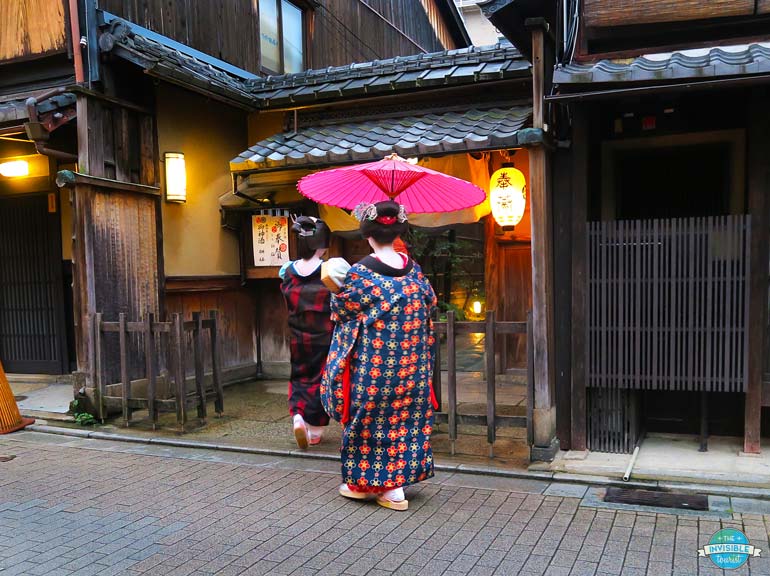
Sending a big thanks to MagicalTrip for having me on this unforgettable experience, and Hikari-san for being a fantastic guide and interpreter!
While you’re here, why not take a look at detailed Japan travel blog? I’ve shared my personal itineraries for 2 weeks or 3 weeks in Japan to help plan your trip (or your Japan honeymoon), learn some basic Japanese phrases for tourists with my free PDF cheat sheet, find out what to pack for Japan, some travel guides for lesser-known destinations such as the Izu Peninsula and Okinawa, how to spend 10 days in Japan to avoid crowds — I have every step of your Japan planning journey covered!
I’d also love if you could join my free Japan Off the Beaten Path Facebook Group or follow along on Facebook, YouTube, Pinterest, Instagram and TikTok for more Japan inspiration!
Until next time,

Like it? Pin it! 📌
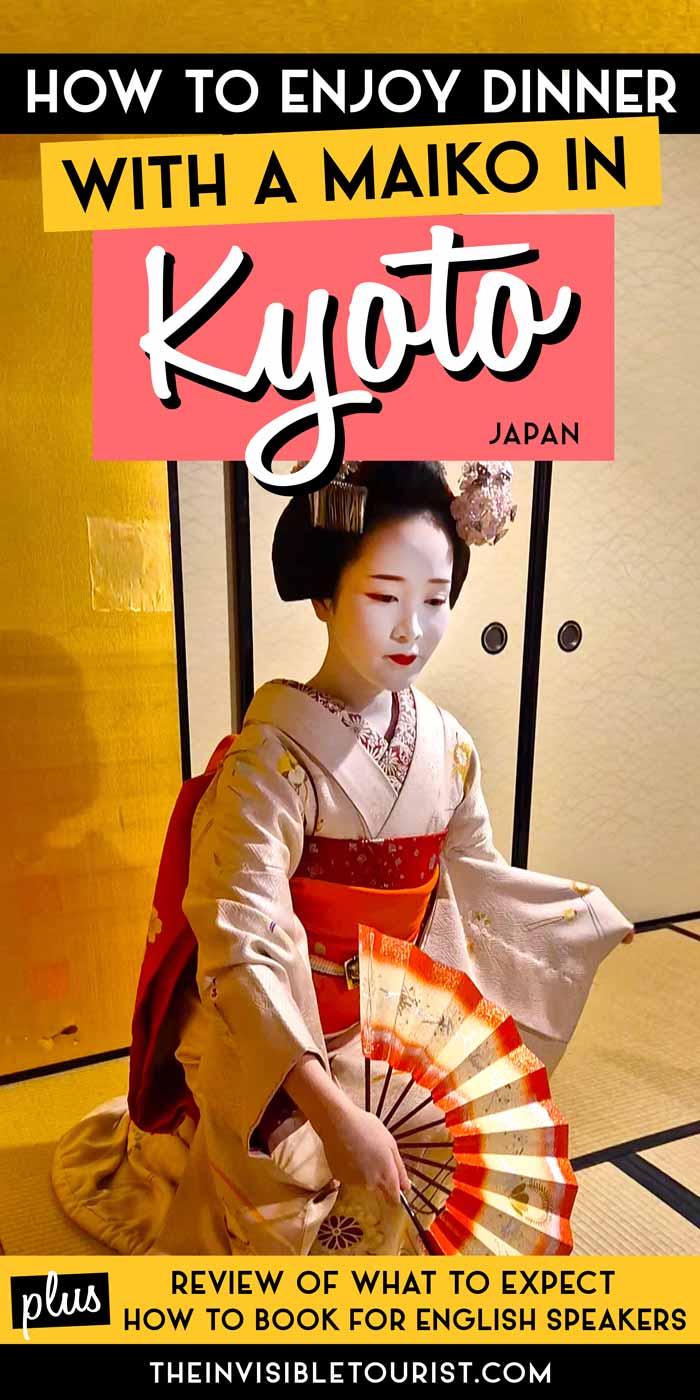
This guide to meeting a maiko in Kyoto contains some affiliate links, at no extra cost to you. I may earn a small commission if you decide to make a purchase and if you do, thanks for your support! This helps with the costs of running my blog so I can keep my content free for you. As always, I only recommend a product or service that I genuinely love and use myself!
